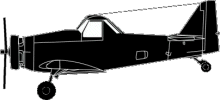
ASN Wikibase Occurrence # 179045
This information is added by users of ASN. Neither ASN nor the Flight Safety Foundation are responsible for the completeness or correctness of this information.
If you feel this information is incomplete or incorrect, you can submit corrected information.
| Date: | Wednesday 26 August 2015 |
| Time: | 11:30 |
| Type: |  Weatherly 620B |
| Owner/operator: | Agricair Flying Service, Inc |
| Registration: | N2005C |
| MSN: | 1557 |
| Year of manufacture: | 1993 |
| Total airframe hrs: | 4811 hours |
| Engine model: | Pratt & Whitney R-985 AN-14B |
| Fatalities: | Fatalities: 1 / Occupants: 1 |
| Aircraft damage: | Destroyed |
| Category: | Accident |
| Location: | Waushara County at Hancock, WI -
 United States of America United States of America
|
| Phase: | Manoeuvring (airshow, firefighting, ag.ops.) |
| Nature: | Agricultural |
| Departure airport: | Bancroft, WI (PVT) |
| Hancock, WI | |
| Investigating agency: | NTSB |
| Confidence Rating: |
The commercial pilot was performing an agricultural application flight. As the airplane neared trees at the edge of the field, the pilot performed a pull-up maneuver to initiate a turn and to align for the next spray pass; during this maneuver, portions of the left wing separated from the airplane. The airplane then continued until it impacted trees and the ground beyond the edge of the field.
Postaccident examination revealed that the two left center section forward spar lower hinge brackets were fractured vertically through the pin holes. Examination of the failed brackets revealed the presence of fatigue cracking on all four of the fracture faces, which initiated at corrosion pits along the pin hole bores. An engineering study showed that the stress intensity caused by the fatigue cracks on the accident airplane would allow for failure of the center section hinge bracket at a load factor of about 2.7 g, well below the design limit load factor of 3.8 g. The operator reported that, during application flights, they typically experience load factors about 2 g during normal maneuvers, and up to 3 g for more severe maneuvers. The left wing failure initiated with the failure of the left lower forward center wing hinge bracket. After the failure of the forward bracket, the geometry of the bracket assembly allowed for eccentric loading of the remaining (aft) bracket. The bending stress and eccentric loading induced in the aft bracket, when added to the normal tension stress, quickly exceeded the capability of the bracket and resulted in its failure. The catastrophic failure of both left center section lower hinge brackets allowed the left wing to rotate upward under normal aerodynamic loads, rendering the airplane uncontrollable.
Information provided by the operator indicated that the airplane departed on the accident flight at a weight of about 5,084 lbs; its weight at the time of the accident could not be determined and would have varied significantly depending on how much of the field had been sprayed before the accident occurred. The airplane's certified type design maximum gross weight was 4,000 lbs, which allowed for a useful load of about 950 lbs, to include the pilot, usable fuel, hopper load, and spray system; this load is impractical for agricultural operations. While certification in the restricted category allows for operation above the airplane's maximum gross weight, it requires that the operator verify the airplane's handling characteristics at that weight and document the increase in the aircraft logbooks. Such an entry was not found in the maintenance logs for the accident airplane. Additionally, operating an airplane at higher weights will impose higher loads on the aircraft structure and reduce the structure's static strength capabilities and the limit load factor. Further, at higher weights, the aircraft structure will accumulate fatigue damage at a faster rate. There was no evidence that the aircraft manufacturer had performed any analysis to substantiate operation at higher gross weights for the accident airplane make and model.
Probable Cause: The in-flight failure of the left wing lower forward attach point under normal loading conditions due to corrosion and fatigue cracking in the center section hinge brackets. Contributing to the accident was the operator's inadequate maintenance and overweight operation of the airplane, and the manufacturer's inadequate guidance to detect and prevent corrosion and fatigue cracking.
Accident investigation:
 |
|
Sources:
NTSB
FAA register: http://registry.faa.gov/aircraftinquiry/NNum_Results.aspx?NNumbertxt=2005C
Location
Images:

Photo: NTSB
Revision history:
| Date/time | Contributor | Updates |
|---|---|---|
| 27-Aug-2015 05:41 | Geno | Added |
| 27-Aug-2015 15:44 | Geno | Updated [Registration, Cn, Operator, Source] |
| 03-Sep-2015 01:46 | Geno | Updated [Source] |
| 21-Dec-2016 19:30 | ASN Update Bot | Updated [Time, Damage, Category, Investigating agency] |
| 01-May-2018 13:44 | ASN Update Bot | Updated [Operator, Departure airport, Destination airport, Source, Narrative] |
| 01-May-2018 13:58 | harro | Updated [Source, Narrative, Photo, ] |
Corrections or additions? ... Edit this accident description
The Aviation Safety Network is an exclusive service provided by:


 ©2024 Flight Safety Foundation
©2024 Flight Safety Foundation